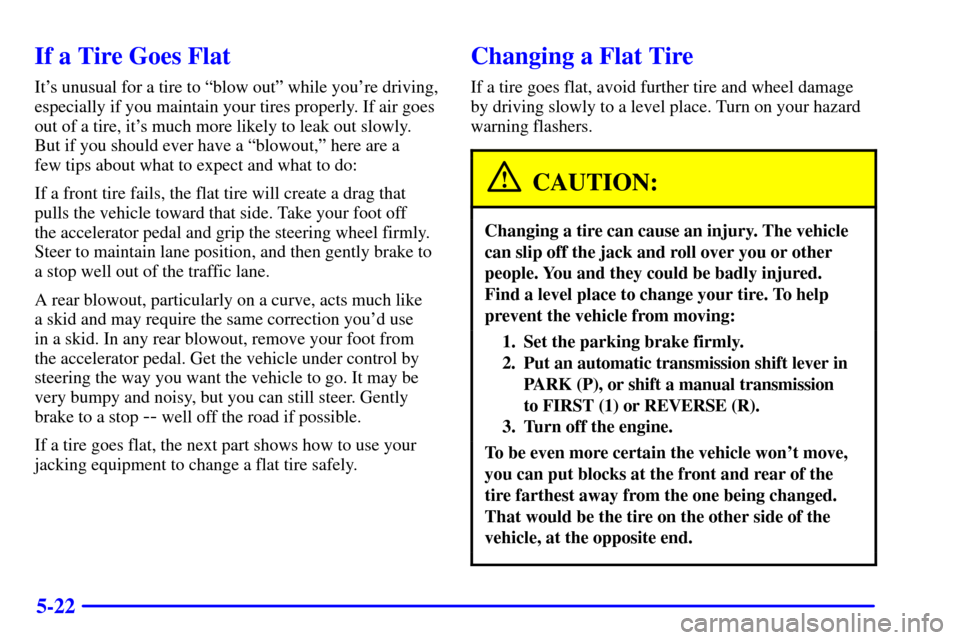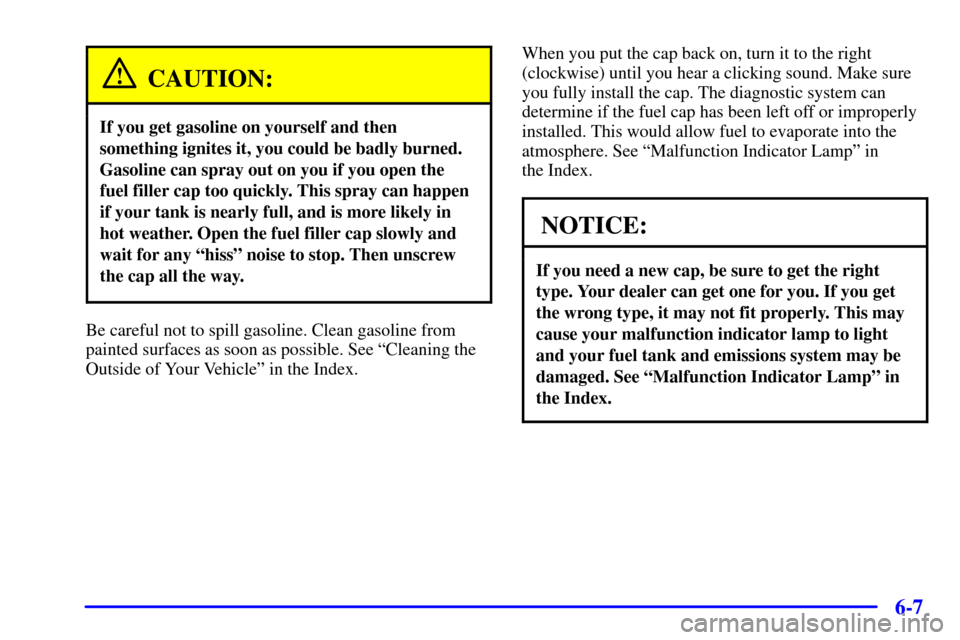Page 238 of 357

5-22
If a Tire Goes Flat
It's unusual for a tire to ªblow outº while you're driving,
especially if you maintain your tires properly. If air goes
out of a tire, it's much more likely to leak out slowly.
But if you should ever have a ªblowout,º here are a
few tips about what to expect and what to do:
If a front tire fails, the flat tire will create a drag that
pulls the vehicle toward that side. Take your foot off
the accelerator pedal and grip the steering wheel firmly.
Steer to maintain lane position, and then gently brake to
a stop well out of the traffic lane.
A rear blowout, particularly on a curve, acts much like
a skid and may require the same correction you'd use
in a skid. In any rear blowout, remove your foot from
the accelerator pedal. Get the vehicle under control by
steering the way you want the vehicle to go. It may be
very bumpy and noisy, but you can still steer. Gently
brake to a stop
-- well off the road if possible.
If a tire goes flat, the next part shows how to use your
jacking equipment to change a flat tire safely.
Changing a Flat Tire
If a tire goes flat, avoid further tire and wheel damage
by driving slowly to a level place. Turn on your hazard
warning flashers.
CAUTION:
Changing a tire can cause an injury. The vehicle
can slip off the jack and roll over you or other
people. You and they could be badly injured.
Find a level place to change your tire. To help
prevent the vehicle from moving:
1. Set the parking brake firmly.
2. Put an automatic transmission shift lever in
PARK (P), or shift a manual transmission
to FIRST (1) or REVERSE (R).
3. Turn off the engine.
To be even more certain the vehicle won't move,
you can put blocks at the front and rear of the
tire farthest away from the one being changed.
That would be the tire on the other side of the
vehicle, at the opposite end.
Page 239 of 357
5-23
The following steps will tell you how to use the jack and
change a tire.
Removing the Spare Tire and Tools
The equipment you'll need is located in the rear area
behind the trim panel on the passenger's side.
First you must remove the cargo cover. See ªCargo
Coverº in the Index.
On convertible models, you must also remove the trunk
access panel. It's at the upper back of the trunk. Turn the
two wing fasteners under the trunk edge a quarter turn
counterclockwise to remove the panel.
Page 240 of 357
5-24
Find the plastic screw heads in the trim panel over the
spare tire. See ªCompact Spare Tireº later in this section
for more information about the compact spare. Use a
coin or a key to turn the screw heads until the slots point
front and back to the unlock position. Gently lift the trim
panel front forward edge and remove the panel.If you have speakers in the trim panel, you may have to
disconnect the wire from the speaker. The speaker wire
may be long enough to remove the trim panel without
disconnecting the wire.
To remove the jack and wheel wrench, loosen and
remove the plastic cover.
Page 242 of 357
5-26
The jack has a bolt at the end. Attach the wheel wrench
to the jack bolt.
Turn the wheel wrench clockwise to raise the lift head
a little.
If your wheel has a center cap, pry it off using the
wheel wrench.If your vehicle has a bolt-on wheel cover, loosen the
plastic caps using the wheel wrench and remove the
wheel cover.
If your vehicle has optional alloy wheels, first remove the
decorative nut caps using the wheel wrench. Each wheel
may have one locknut in place of the standard wheel nut.
A special wheel lock key (removal tool) and instructions
are located in the center console. Attach the wheel lock
key to the socket of the wheel wrench. Remove the
locking wheel nut by turning it counterclockwise.
Page 245 of 357
5-29
CAUTION:
Getting under a vehicle when it is jacked up is
dangerous. If the vehicle slips off the jack, you
could be badly injured or killed. Never get under
a vehicle when it is supported only by a jack.
CAUTION:
Raising your vehicle with the jack improperly
positioned can damage the vehicle and even make
the vehicle fall. To help avoid personal injury
and vehicle damage, be sure to fit the jack lift
head into the proper location before raising
the vehicle.3. Raise the vehicle by turning the wheel wrench
clockwise. Raise the vehicle far enough off the
ground so there is enough room for the spare tire
to fit.
4. Remove all the wheel nuts and take off the flat tire.
Page 247 of 357
5-31
7. Lower the vehicle by turning the wheel wrench
counterclockwise. Lower the jack completely.
8. Tighten the wheel
nuts firmly in a
crisscross sequence
as shown.
Install the plastic caps for the bolt
-on wheel cover
or the decorative plastic caps if your vehicle has the
optional alloy wheels. Tighten the caps by hand then,
using the wheel wrench, tighten an additional
one
-quarter turn.
Page 257 of 357
6-6
Filling Your Tank
CAUTION:
Gasoline vapor is highly flammable. It burns
violently, and that can cause very bad injuries.
Don't smoke if you're near gasoline or refueling
your vehicle. Keep sparks, flames and smoking
materials away from gasoline.
The cap is located behind a hinged door on the driver's
side of your vehicle.
While refueling, hang the cap by the tether from the
hook on the filler door.
To remove the cap, turn it slowly to the left
(counterclockwise). The cap has a spring in it; if you let
go of the cap too soon, it will spring back to the right.
Page 258 of 357

6-7
CAUTION:
If you get gasoline on yourself and then
something ignites it, you could be badly burned.
Gasoline can spray out on you if you open the
fuel filler cap too quickly. This spray can happen
if your tank is nearly full, and is more likely in
hot weather. Open the fuel filler cap slowly and
wait for any ªhissº noise to stop. Then unscrew
the cap all the way.
Be careful not to spill gasoline. Clean gasoline from
painted surfaces as soon as possible. See ªCleaning the
Outside of Your Vehicleº in the Index.When you put the cap back on, turn it to the right
(clockwise) until you hear a clicking sound. Make sure
you fully install the cap. The diagnostic system can
determine if the fuel cap has been left off or improperly
installed. This would allow fuel to evaporate into the
atmosphere. See ªMalfunction Indicator Lampº in
the Index.
NOTICE:
If you need a new cap, be sure to get the right
type. Your dealer can get one for you. If you get
the wrong type, it may not fit properly. This may
cause your malfunction indicator lamp to light
and your fuel tank and emissions system may be
damaged. See ªMalfunction Indicator Lampº in
the Index.